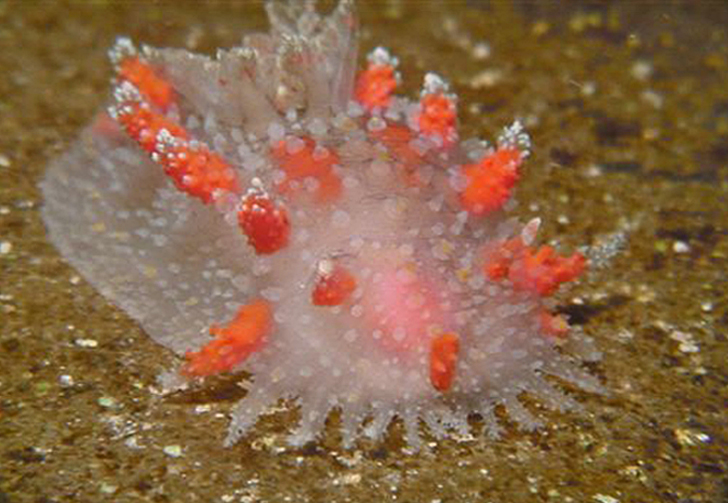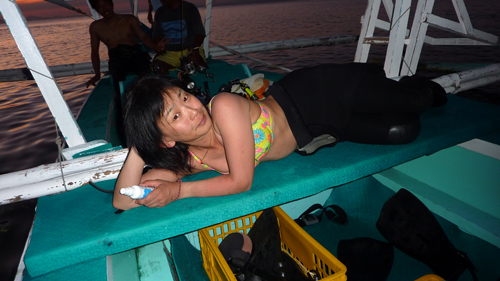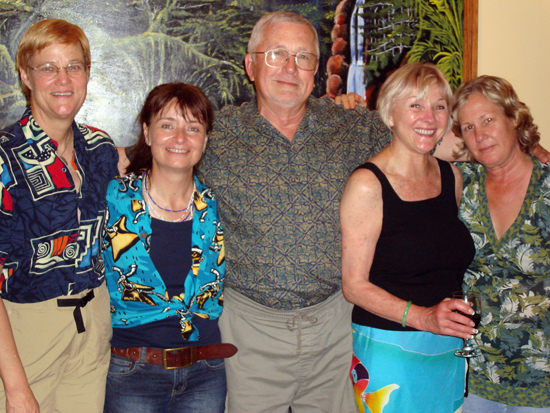 |
Kalinga ornata
Image courtesy of John GreenamyerAnilao Pier, Batangas, Philippines
Image taken with Sony HC-1 Camcorder in still frame mode
Copyright 2010 John Greenamyer
Kalinga ornata Alder & Hancock, 1864
This BOW is the result of the most productive field trip made to the Philippines since first going there in the early 80's. More to come on that in succeeding in BOW's. What I would like to focus on this week is a species that is akin to the "Holy Grail" of nudibranching! First brought to my attention back in 1999 by Mary Jane Adams as a BOW featuring the "Alien" , I never thought( as with most other people on the trip)that I would have the opportunity to see it in the field or for that matter see it all under any circumstances in my lifetime. Roger Steene, the noted Australian underwater photographer had it number one on his list of branchs to see. It was also number one on my list but again I had little hope of ever seeing it. You can imagine the elation we all felt upon arriving at Club Ocellaris on May 16th of seeing and hearing reports of multiple specimen sightings at Anilao Pier! John Greenamyer was able video Kalinga ornata in HD so when we can process that footage, it will be made available on the site. Probably will be a first for a video HD posting of an animal so rare!
This is what Terry Gosliner had to say back in 1999
"...Kalinga ornata has been known for a long time. It was originally described by Alder and Hancock from Coromandel, India. It has been found sporadically from isolated localities ranging from South Africa to the Hawaiian Islands. It is usually an inhabitant of subtidal waters. I have seen records from 16-36 meters depth. It has been beautifully illustrated in the suppplement to Kikutaro Baba's Opisthobranchs of Sagami Bay and photos of the animals appear in Willan and Coleman and in Kay and Schoenberg's Hawaiian shell book.
Little is known about its biology. It is much broader than the phanerobranch dorids to which it is most closely related (things like Plocamopherus and Kaloplocamus). This probably accounts for some of its "alien" appearance. Virtually nothing is known about its biology. Mary Jane's observations that it is nocturnal and burrows in the sand explain why it has not been seen very often. Its behavior of probing the bottom and everting its mouth is very curious. Its relatives all feed on bryozoans, but what it is doing is very mysterious. Its broad body and wide oral veil are convergent with notaspideans that inhabit the same region, things like Pleurobranchaea brockii and Euselonops luniceps. It sure looks like a macro-predator, but we obviously lack the information to say this conclusively. It is a really amazing beast!..."
In the ensuing years, little has been added to the meager knowledge regarding the feeding habits, etc. of this elusive creature. That is until now! We had a Japanese contingent on our trip who didn't seem to register any excitement on the finding. This puzzled me somewhat so I finally asked Rie Nakano about it. It was then I found out that K. ornata is seen with some regularity in Tokyo Bay and she was in fact studying K. ornata as a part of her graduate studies at the Graduate School of Engineering and Science at the University of the Ryukyus, Okinawa. I hope the disclosure of some of her results will not preempt future work, but I found it interesting that Rie and her collaborators have found that K. ornata was documented to feed on brittle stars! Now isn't that amazing!
Rie Nakano resting between dives

Send Rie email at rie_nakano1213@divers.ne.jp |
San Diego, CA
May., 2010
John with friends at Tawali Resort in PNG

BEEN DIVING SINCE 1983 AND HAVE OVER 3500 DIVE LOGGED. I HAVE BEEN TO MOST EVERY WARM WATER DISTINATION. BORNEO , THAILAND,SOLOMONS,PNG,PHILLIPINES,RED SEA,INDONESIA,MEXICO,COSTA RICA. I HAVE DONE THE BIG ANIMALS EARLY ON BUT FIND IT MOST REWARDING TO GO ON TRIPS WITH RODGER STEENE AND NEVILLE COLEMAN AND FIND THE NEVER BEFORE SEEN LITTLE NUDI'S. MY FAVORITE PLACE IS MILNE BAY , PNG ON BOARD THE CHERTAN AND FROM THE TAWALI RESORT WHERE I HAVE A TIME SHARE HOUSE, BUT ANILOA ,PI IS ALSO A FAVORITE. IM MOSTLY SHOOTING HD MACRO VDO BUT DO STILLS ALSO AS A BACKUP. FROM SAME CAMCORDER. THIS PICTURE IS AT TAWALI WITH DIVE BUDDYS. LIVE AND LOVE THE OUTDOORS. LIVED IN RUNNING SPRINGS, CA FOR PAST 40 YEARS HAVE LIVED Send John email at mrjhon69@verizon.net Webmaster's Notes: John Greenamyer probably doesn't need an introduction to most sluggers. John has been contributing videos to the site for some time! In fact, the Tambja video above will be John's 71th presentation on the Slug Site! Pretty incredible when you think about it, to give up taking video of big guys to video our little friends which I believe is up to the challenge of taking video of the larger animals if you are fortunate to find any nowadays! John has been an inspiration along with Alan Grant for prompting my own entry into the world of High Definition Video back in 2006. I am very thankful for the guidance given by both and have never looked back! As the ol' saying goes, it just gets better and better (especially when you are looking at John's videos!).
San Diego, Calif |

|
